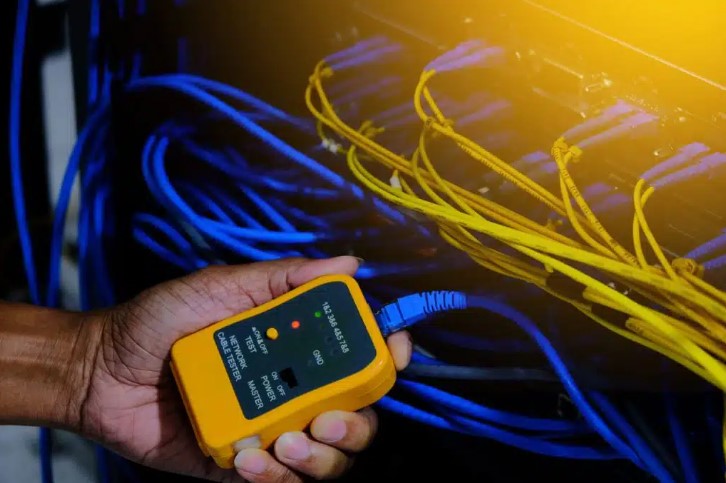Do’s and Don’ts to Run Cable Along Existing Cable

If you want to run cable along existing cable, there are a few considerations to bear in mind. First, it’s important to consider what types of cable you’re running. While some cables can be run alongside each other, others cannot for safety reasons. Additionally, running network cables with other network cables can affect speeds.
Below, we’ll discuss considerations for running cable along existing cable, and we’ll look at some strategies for installing the cable.
Can You Run Network Cable Along Existing Cable?
Running two network cables alongside each other doesn’t raise a safety concern. However, running two network cables closely together or parallel to each other can cause crosstalk and interference. This was true more so in the past when cables were less sophisticated than they are today, but it’s still a consideration even with high-quality cables today.
That being said, many times people do run cable along existing cable. This is especially true in areas that run a lot of network cable, such as a data center. Separating cables can also be unavoidable in certain types of construction, such as old or historic buildings.
The amount of interference from running cables along each other depends largely on the quality of the cable. For example, higher category Ethernet cables are less susceptible to crosstalk and interference in general, so they will fare better when being run along existing cable. With very high quality cables, the amount of service degradation likely won’t be enough to cause an issue. If you have to run cables together, choose shielded cables. This will help reduce any interference from other cables as well as from outside sources.
If you want the best connection and service possible, however, it’s best to avoid running network cable along existing network cable.
Can You Run Network Cable in the same Conduit as Power?
It is not safe, nor would it be good for your network, to run network cables along with power cables. In general, it is safe to run Ethernet cables, coaxial cables, and low voltage power cables alongside each other. You cannot, however, run standard or high voltage power cables alongside network cables.
Running standard power and network cables together presents both a safety risk and a network integrity risk. When these cables are too close together, they can cause an electrical fire.
Additionally, electrical wires can generate interference when they are too close to network wires. The amount of interference they cause can vary, with wires running more amperage causing more interference. You’ll also get more interference with lower quality network cables.
How Far Apart Should I Space Cables?
General guidelines regarding how far apart cables should be vary based on many factors, including whether the cables are indoors or outdoors, whether there is a barrier between the cables, and whether the cables are shielded or not. It’s a good idea to have at least eight inches between power cables and network cables, and ideally more than 12 inches. Network cables and power cables should never be run within the same conduit.
Sometimes, it’s inevitable for cables to come within close proximity of each other. In these cases, continue to keep the cables as far apart as possible and use shielded, high-quality cables. If your cables must cross paths, they should do so at a 90-degree angle. This will reduce the proximity the wires have to each other.
Can I Pull Cable Using an Existing Cable?
If you’ve decided that you’re going to run cable along existing cable, you can actually pull the new cable using the existing cable. It’s a relatively easy way to get your cables in the correct location, be it in a wall, behind a baseboard, or in a ceiling.
Below are step-by-step directions to pull cable using existing cable:
- To start, disconnect your equipment and tape any exposed wire ends.
- Then, attach a pull string to the end of the cable where the new cable will terminate.
- After you make sure your string is securely attached and that it’s more than long enough, pull the cable out of the wall at the point where the new cable will enter the wall. Be careful not to let your pull string come all the way through the wall as well.
- Next, secure the two cables together and pull them through the wall with your attached pull string.
Once you’ve completed these steps, you’ll be ready to terminate your new cable. If you are upgrading to a new cable type and won’t be using the existing cable anymore, you can remove it from the wall after step 3. Removing any unused cable will help keep your cable runs clean, create space, and reduce any tangling or twisting. This will also serve to reduce confusion any time somebody works with your cables in the future.
When to Run Cable Along Existing Cable
There is a time and a place to run cable along existing cable. If you are using high-quality shielded network cables, you can likely get away with running your cables together. You might face some degradation of your service, but not enough to cause a major issue. You can also run network cable along low voltage cables. In some cases, low voltage wiring is even included with network wiring in one cable, referred to as power over Ethernet (PoE).
It’s never safe to run network cables along power cables. Doing so is a fire hazard, and it’s not a good idea for the quality of your network, anyway. This may mean you need to find a new place to install your cables, and it may require more cabling to reroute cables safely. However, it’s an important rule for the safety of yourself and those in your building.
Contact us Today!
ADDRESS
- Western Heights, 5th Floor, Karuna Close.
PAGES
- About US
- Our Services
- Blog
- Contact Us
